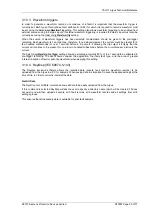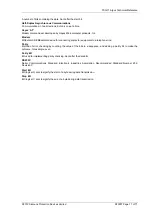
7SG11 Argus Technical Reference
©2013 Siemens Protection Devices Limited
P20007 Page 66 of 71
4.2.13 Data Echo
Argus relays may be connected in a ring, e.g. as shown in Fig.4.2-3. The optical ring architecture requires data to
be passed from one relay to the next, therefore, when using this method, all relays in the ring must have the
Communications Interface:
Data Echo
setting to
On
.
For Argus with individual connections (e.g. Fig.4.2-1 & Fig.4.2-2), or connected in a star topology (e.g. Figure 4.2-
4), the setting should be set to
Off
.
Table 4-1
Communications Settings
Sub-menu:
Communications Interface
4.2.14 Modems
The communications interface has been designed to allow data transfer via modems. However, IEC 60870-5-103
defines the data transfer protocol as an 11 bit format of 1 start, 1 stop, 8 data and even parity, which is a mode
most commercial modems do not support. High performance modems will support this mode.
4.2.15 Connecting a Modem to the Relay(s)
RS232C defines devices as being either Data Terminal Equipment (DTE) e.g. computers, or data
Communications Equipment (DCE), e.g. modems, where one is designed to be connected to the other. In this
case, two DCE devices (the modem and the fibre-optic converter) are being connected together, so a null terminal
connector is required, which switches various control lines. The fibre-optic converter is then connected to the
relay network Tx to Relay Rx and Rx to Relay Tx.
4.2.16 Setting the Remote Modem
The exact settings of the modem are dependent on the type of modem. Although most modems support the basic
Hayes ‘AT’ command format, different manufacturers use different commands for the same functions. In addition,
some modems use DIP switches to set parameters, others are entirely software configured.
Before applying the following settings, the modem’s factory default settings should be applied, to ensure it is in a
known state.
Several factors must be considered to allow remote dialling to the relays. The first is that the modem at the
remote end must be configured as auto answer. This will allow it to initiate communications with the relays. Next,
the user should set the data configuration at the local port, i.e. baud rate and parity, so that communication will be
at the same rate and format as that set on the relay and the error correction is disabled.
Auto-answer usually requires two parameters to be set. The auto-answer setting should be switched on and the
number of rings after which it will answer selected. The Data Terminal Ready (DTR) settings should be forced on.
This tells the modem that the device connected to it is ready to receive data.
The parameters of the modem’s RS232C port are set to match those set on the relay, set baud rate and parity to
be the same as the settings on the relay and number of data bits to be 8 and stop bits 1. Note, although the Argus
may be able to communicate with the modem at say 19200 bps, the modem may only be able to transmit over the
telephone lines at 14400 bps. Therefore, a baud rate setting on which the modem can transmit should be chosen.
In this example, a baud rate of 9600 should be chosen.
As the modems are required to be transparent, simply passing on the data sent from the controller to the device
and vice versa, error correction and buffering should be turned off.
Setting name
Range (
bold
= default)
Units
Notes
Comms Protocol
IEC 60870-5-103
, MODBUS-RTU (Modbus-RTU
not available in Argus 4 & Argus 6)
IEC Class 2 Measurand
ASDU 3
, ASDU 9
Class 2 Update Period
INST
, 1, 2 .. 60
Sec
IEC Class 2 Scaling
1.2x
, 2.4x
Comms Baud Rate
75, 110, 150, 300, 600, 1200, 2400, 4800, 9600,
19200
baud
Comms Parity
NONE,
EVEN
Relay Address
0
, 1…254
Line Idle
LIGHT ON,
LIGHT OFF
Data Echo
OFF
, ON






























